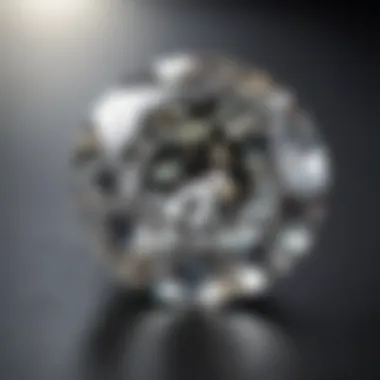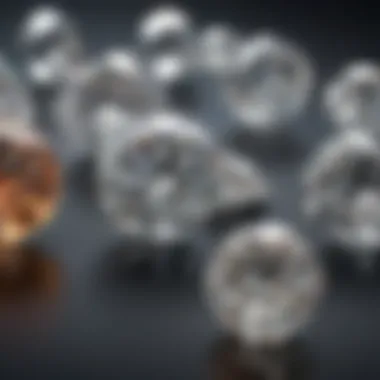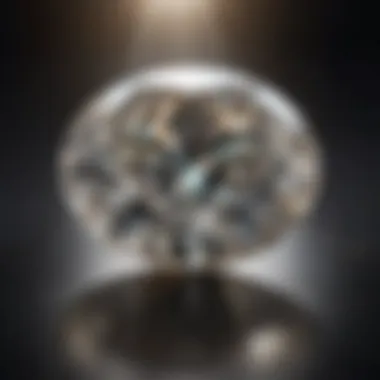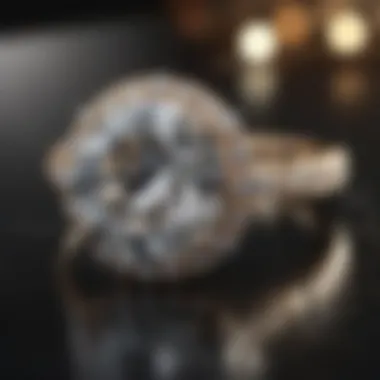Understanding the True Value of Moissanite Diamonds


Intro
The exploration of moissanite diamonds reveals an intricate tapestry of value that transcends mere aesthetics. Understanding what makes these gemstones unique is essential for anyone considering them for personal adornment or investment. This article aims to dissect the elements that contribute to the worth of moissanite diamonds, focusing on their properties, market position, and comparisons to natural diamonds.
Gemstone Overview
Definition and Characteristics
Moissanite is a lab-created gemstone known for its brilliance and fire. Unlike natural diamonds, which are formed over millions of years deep within the Earth’s mantle, moissanite is synthesized through advanced processes developed in laboratories. This results in a stone that closely resembles diamonds in appearance but differs in composition. Moissanite is made up of silicon carbide, a compound that gives it remarkable hardness and optical properties. On the Mohs scale, moissanite ranks between 9.25 to 9.5, making it an extremely durable choice for jewelry. The gemstone’s refractive index is notably higher than that of diamonds, contributing to its sparkling display.
Classification of Gemstones
Gemstones are classified into two primary categories: precious and semi-precious. Traditionally, diamonds, sapphires, rubies, and emeralds constitute the precious group. Moissanite, while not traditionally listed among these precious stones, falls into a category of its own as a laboratory-cultured gem. This classification process takes into account the stone's rarity, value, and the methods of its creation. The unique properties of moissanite, such as its brilliance and durability, make it a compelling alternative for those seeking ethical or cost-effective options without sacrificing quality.
Historical Significance
Ancient Uses and Cultural Importance
Historically, gemstones have carried significant cultural weight, often linked to power, love, or wealth. While moissanite itself does not have a long historical record due to its recent introduction, the natural form of silicon carbide has been discovered within meteorites, indicating its extraterrestrial origins. In ancient times, such stones were believed to have mystical properties, and moissanite, in modern contexts, now attracts attention for its eco-friendly and sustainable nature compared to mined diamonds. As environmental awareness has grown, moissanite’s popularity has surged among consumers, as it represents a responsible choice in gemstone selection.
Myths and Legends Surrounding Gemstones
Many gemstones are surrounded by myths that enhance their allure. For instance, diamonds have long been associated with invincibility and eternal love. Moissanite, although lacking a storied past, is often encompassed in modern narratives that emphasize its ethical production and affordability. This gemstone is increasingly featured in discussions about sustainability and luxury, challenging traditional beliefs about value and beauty in the gemstone market.
Prolusion to Moissanite Diamonds
Moissanite diamonds represent a fascinating alternative to natural diamonds, providing unique attributes that capture both and consumer interest. Understanding moissanite is crucial for gemstone enthusiasts, collectors, and designers alike. This section lays the groundwork, outlining the significance of moissanite as a choice for those seeking beauty and affordability in their jewelry.
Definition and Origin
Moissanite is a rare mineral composed of silicon carbide. Originally discovered in a meteoritic mineral by Henri Moissan in 1893, its natural occurrence is incredibly rare. Most of the moissanite available today is lab-created, allowing for a responsible approach to sourcing without the ethical concerns often associated with mined diamonds. These lab-generated stones deliver similar qualities to mined moissanite, but with a more consistent supply.
Characteristics of Moissanite
Moissanite stands out for its remarkable physical and optical properties. Here are some key characteristics:
- Brilliance: Moissanite has a higher refractive index than diamonds, resulting in exceptional sparkle.
- Fire: The dispersion of light in moissanite creates a colorful brilliance that can surpass that of a diamond.
- Hardness: On the Mohs scale, moissanite scores close to diamond, with a hardness of 9.25, making it highly durable for everyday wear.
Comparative Analysis with Natural Diamonds
In the realm of gemstones, the comparison of moissanite to natural diamonds is essential for understanding their respective values. As more consumers explore alternative options to traditional diamonds, moissanite emerges as a popular contender due to its unique properties and affordability. This analysis examines physical properties, optical characteristics, and durability, highlighting the advantages and limitations of each stone.
Physical Properties
Moissanite and natural diamonds differ significantly in their physical structures, which influences their overall appearance and feel. For instance, natural diamonds, composed of carbon atoms arranged in a crystalline structure, exhibit hardness of 10 on the Mohs scale. Moissanite, on the other hand, is made up of silicon carbide, resulting in a hardness of 9.25, which is still very impressive, yet falls short of diamond’s renowned toughness.


However, moissanite does have superior thermal conductivity compared to diamonds, meaning it disperses heat more effectively. This can influence how each stone feels during wear; moissanite might feel cooler against the skin than its diamond counterpart. Beyond hardness, their specific gravity varies as well. Diamonds are heavier than moissanite, impacting their size perception. Depending on personal preference, this difference might be significant for buyers considering which stone suits their aesthetic desires.
Optical Properties
Optical properties showcase where moissanite truly shines compared to natural diamonds. The most notable is moissanite's brilliance. With a refractive index of approximately 2.65 to 2.69, moissanite is more brilliant than diamonds, which boast a refractive index of 2.42. This leads to a striking appearance that some find more desirable than that of natural diamonds.
Moreover, moissanite tends to display a double refraction effect, meaning it can appear to have two images of one facet when viewed through it. This property, while captivating for some, may not appeal to everyone; those preferring the classic look of a natural diamond might find it less appealing. Despite the differences, both stones diffraction light beautifully, making them excellent choices for gemstones.
Durability
Durability is a major consideration when evaluating gemstones for everyday wear, particularly in engagement rings and fine jewelry. Natural diamonds, recognized for their extraordinary hardness, fend off scratches and abrasions efficiently. At their peak, they can resist normal wear and tear, making them a reliable choice.
In contrast, moissanite, while still quite durable, lacks the absolute hardness of diamonds. The rating of 9.25 signifies that although it is streets ahead of many gems, it’s not as invulnerable as diamonds. In practical terms, this means that while moissanite will withstand typical wear, it may require slightly more cautious handling to preserve its pristine appearance.
"Comparing moissanite to natural diamonds reveals significant differences that can impact consumer choices. Understanding these distinctions can guide buyers towards more informed decisions."
Factors Influencing Moissanite Value
Understanding the factors that influence the value of moissanite diamonds is essential for anyone interested in this gemstone. These factors help define the quality and desirability of a moissanite stone. Knowing them can aid buyers and sellers in making informed decisions. Here, we will explore four key elements: cut quality, color grading, clarity ratings, and carat weight. Each contributes significantly to the overall worth of moissanite.
Cut Quality
The cut quality of a moissanite is crucial in determining its brilliance and overall visual appeal. A well-cut stone reflects light effectively, enhancing its sparkle. Poor cut quality can result in a dull appearance, diminishing its value. When evaluating cut quality, several factors come into play, including:
- Symmetry: The way the facets align affects light performance.
- Proportions: Correct proportions allow for optimal light reflection.
- Finish: The smoothness of the facets impacts the light's entry and exit.
For buyers, it is important to look for certified ratings from reputable grading companies. These certifications validate the cut quality and help ensure that the stone has been evaluated by a trained professional. A higher cut quality typically indicates a higher market value.
Color Grading
Color grading is another vital aspect influencing moissanite value. Moissanite comes in various colors, and these colors can range from near colorless to shades of yellow, green, or brown. The most sought-after stones are those that have a near-colorless appearance. When assessing color, the following factors should be taken into account:
- Hue: The predominant color of the stone.
- Tone: The lightness or darkness of the stone.
- Saturation: The intensity of color.
Typically, colorless and near-colorless moissanites are more cherished, resulting in a higher market valuation compared to colored variants. Thus, understanding these differences is essential for potential buyers and collectors.
Clarity Ratings
Clarity is defined by the presence of inclusions or blemishes on the surface or within the stone. Moissanite, like diamonds, is graded based on these characteristics. Generally, the fewer inclusions a stone has, the more valuable it becomes. Here are some categories of clarity ratings:
- Flawless: No inclusions visible under 10x magnification.
- Very Slightly Included (VSI1 and VSI2): Minor inclusions not easily seen.
- Slightly Included (SI1 and SI2): Inclusions are noticeable under magnification but may not be visible to the naked eye.
Higher clarity ratings enhance the aesthetic appeal and resale value of moissanite, making it an important factor to consider when purchasing.
Carat Weight


Carat weight is a straightforward but significant aspect. Carat measures the weight of the stone, where one carat equals 0.2 grams. In general, larger stones tend to be more valuable due to their scarcity. However, it is vital to balance carat weight with cut, color, and clarity to understand the overall stone’s value. This can include:
- Size Appearance: A well-cut stone may appear larger than its actual weight due to light performance.
- Market Demand: Larger stones experience higher demand.
When assessing a moissanite’s value, carat weight should not be considered in isolation but as part of a holistic view that includes cut quality, color grading, and clarity ratings.
"Evaluation of moissanite value spans multiple factors. Understanding how these factors interplay gives buyers clarity in decisions."
Each of these elements works in conjunction, shaping the overall worth of moissanite diamonds. Buyers should keep these aspects in mind to make well-informed investments.
Market Valuation of Moissanite
Understanding the market valuation of moissanite is crucial for both potential buyers and sellers. This section sheds light on the economic landscape surrounding these gemstones, highlighting the aspects of pricing, market trends, and overall value perception. Moissanite offers an intriguing alternative to natural diamonds, yet many still question its worth. Analyzing market dynamics can help buyers make informed decisions while also providing insights into the gemstone's future potential.
Pricing Trends
The pricing trends of moissanite diamonds have been influenced by a variety of factors including demand, production costs, and competition with natural diamonds. In recent years, prices for moissanite have seen a downward trend compared to natural diamonds, mainly due to improved production techniques and increased availability.
- Cost-Effective Alternative: The starting prices for high-quality moissanite are significantly lower than those of natural diamonds of comparable weight and quality. This factor often attracts budget-conscious consumers looking for an ethical option.
- Market Demand Influences Prices: As consumer awareness and demand for ethical gemstones rise, the price trends for moissanite have begun to reflect this change. Buyers are becoming more interested in transparent pricing and fair trade practices.
- Comparative Analysis: It's essential to note that while moissanite is cheaper, the price can still vary widely based on quality factors such as cut, clarity, and carat weight.
This price landscape indicates that moissanite will likely continue to position itself as a value-oriented choice in the gemstone market.
Buying Guides and Resources
For interested buyers, understanding where and how to buy moissanite is essential. Numerous resources are available that help guide consumers through their purchasing decisions.
- Research Reputable Sellers: Platforms like Enchanted Diamonds and Charles & Colvard are known for offering certified moissanite stones. Researching the reputation of sellers is key to ensuring quality.
- Quality Verification: Check for certifications from independent gemological laboratories. Authentic moissanite should come with documentation verifying its quality.
- Buyer's Guides: Online resources, including articles and forums on Reddit, can provide useful tips. Such guides often include information about what to look for when buying moissanite and common pitfalls to avoid.
- Comparison Shopping: Use platforms like Facebook groups and gemstone forums to compare prices and options from various retailers. These spaces often have real customer reviews and experiences shared.
These resources empower buyers to navigate the moissanite market effectively, ensuring they make well-informed choices.
Resale Value Considerations
The resale value of moissanite is a topic that garners much discussion. Unlike natural diamonds, which typically hold value, moissanite's resale market is still evolving.
- Market Perception: Naturally, consumers expect to recoup some value when reselling gemstones. However, moissanite’s lower initial price means that resale values may not be as high as initially hoped.
- Factors Affecting Resale: The resale value can be influenced by brand recognition, quality assessment, and market demand. For instance, branded moissanite like those by MoissaniteCo often fetch higher resale prices.
- Future Trends: Experts speculate that as more consumers recognize moissanite's appeal and sustainability aspects, its resale value may stabilize and even improve over time.
Understanding these factors can help consumers gauge the potential return on investment in moissanite.
"Investing in moissanite doesn't just reflect personal taste; it touches on values of sustainability and ethical sourcing."
In summary, the market valuation of moissanite encompasses a complex interplay of pricing trends, consumer resources, and resale value considerations. For enthusiasts and collectors alike, keeping abreast of these elements is vital in making informed gemstone decisions.
Consumer Perspectives on Moissanite
The value of moissanite diamonds extends beyond their physical properties and market dynamics. Understanding consumer perspectives plays a crucial role in every aspect of the gemstones’ popularity. Not only does it provide insights into personal preferences, but it also paints a larger picture of how moissanite is viewed in the marketplace compared to natural diamonds. Consumers today are more informed and thoughtful about their purchases, and this consideration influences their choices when investing in gemstones. Different factors, such as brand perception and the emotional significance of the stone, affect how moissanite is valued in the eyes of a potential buyer.


Brand Perception
Brand perception significantly influences consumer preferences toward moissanite. Various jewelry brands have adopted moissanite in their collections, attempting to position themselves uniquely in the marketplace. Prominent brands like Charles & Colvard, known for their patented moissanite, emphasize quality and ethical sourcing. This establishes trust among consumers who increasingly prioritize sustainability and ethical practices in their purchasing decisions.
Moreover, the perception of moissanite as a legitimate alternative to natural diamonds has grown. Once seen as a lesser option, the advancements in the production and quality of moissanite have shifted views. Shoppers now appreciate that a high-quality moissanite stone can offer similar characteristics to a diamond at a fraction of the price.
Consumers are also influenced by reviews and testimonials from other buyers. Positive experiences can significantly elevate a brand’s reputation, while any negative feedback can overshadow even the best products. Thus, a brand's ability to maintain a positive image and deliver on quality is paramount in shaping consumer viewpoints.
Emotional Value versus Monetary Value
When considering moissanite, it is essential to explore the balance between emotional and monetary value. For many buyers, purchasing a gemstone is not just about the cost; it involves deep personal connections, often related to significant life events like engagements or anniversaries.
- Emotional Value: Moissanite is often sought after for its beauty and brilliance, symbolizing love and commitment. Many consumers find the allure of a moissanite stone to be just as captivating as that of a natural diamond. Its presence in an engagement ring or pendant can evoke strong feelings, which often outweigh the monetary considerations.
- Monetary Value: While emotional significance plays a large role, the price of moissanite also cannot be ignored. It is usually more affordable than natural diamonds, which attracts budget-conscious purchasers. The financial aspect can sometimes dictate consumer choices, especially for younger buyers or those looking for a more cost-effective option.
"Consumer choice today reflects a deeper understanding of value beyond just price."
Future Trends in Moissanite Market
The future of the moissanite market presents a fascinating landscape influenced by various factors including consumer preferences and technological advancements. Understanding these trends is vital for buyers, designers, and collectors alike. The increasing interest in sustainable products is reshaping how gemstones, specifically moissanite, are viewed in the market. People today are more concerned about ethical sourcing and are looking for gemstones that reflect their values. This changing consumer mindset contributes to the growing popularity of moissanite as a viable alternative to traditionally mined diamonds.
Sustainability and Ethical Sourcing
Sustainability is a key consideration in the future of moissanite. Unlike natural diamonds, which can often have a significant ecological impact, moissanite is lab-created. This method allows for greater control over environmental effects. Here, no mines are needed, reducing disruption to ecosystems. Furthermore, lab-created gems often result in lower carbon footprints, making them appealing to environmentally conscious consumers.
Additionally, many consumers are now asking questions about the source of their gemstones. The ethical dimension of purchasing moissanite resonates well with buyers who wish to avoid the negative implications associated with conflict diamonds. Sourcing practices are critical; buyers want assurances that their purchases do not promote human rights violations or ecological harm. Companies that emphasize transparency about their sourcing practices will likely thrive in this evolving market.
"Consumers today are increasingly informed about where and how products are made. They want to purchase items that align with their values."
Technological Advances in Moissanite Production
Technological innovation plays a pivotal role in shaping the moissanite market's future. With continual improvements in the processes used to create moissanite, quality is expected to rise further. Enhanced methodologies will allow producers to create stones that are indistinguishable from natural diamonds not just in appearance but in durability as well. Advances in synthetic gemstone technology may lead to even more vivid colors and options for consumers.
Moreover, with new production techniques, costs have the potential to decrease, making these stones more accessible to a broader audience. The price elasticity of moissanite is a vital aspect to watch as advances in production technology could lead to greater market competition. As a result, this may increase availability in various settings, like fine jewelry marketplaces and online platforms.
The End
The conclusion of this article ties together the various elements discussed about moissanite diamonds, underscoring their significance as a valuable alternative to natural diamonds. This section serves not just as a recap but as an opportunity to emphasize the unique attributes of moissanite, its market positioning, and the perspectives of consumers and investors.
Summary of Findings
Throughout this exploration, several key findings about moissanite diamonds emerged:
- Distinct Properties: Moissanite offers exceptional brilliance and fire, rivaling some of the best natural diamonds. Its physical and optical properties make it an attractive option for jewelry.
- Comparative Value: The pricing of moissanite is generally lower than that of natural diamonds. This makes it an appealing choice for consumers who seek quality without the high price tag. Furthermore, market trends indicate increasing interest in moissanite as awareness of ethical and sustainable sourcing grows.
- Influencing Factors: Several factors influence the value of moissanite, including cut quality, color grading, clarity ratings, and carat weight. Buyers are encouraged to consider these aspects when assessing the worth of a moissanite diamond.
- Consumer Sentiment: Emotional appeal plays a significant role in how consumers perceive moissanite. Many still associate traditional diamonds with status, while others value moissanite's ethical advantages and affordability.
This comprehensive view highlights how moissanite diamonds sit at an intersection of beauty, value, and morality – presenting an intriguing alternative in the gemstone market.
The Potential of Moissanite as an Investment
In terms of investment, moissanite holds potential benefits that might not be immediately apparent. As awareness of moissanite grows, so too does consumer acceptance and demand. Investing in moissanite can be justified for a few reasons:
- Cost-Efficiency: With lower price points than natural diamonds, investors and consumers can acquire larger and higher quality stones for their money. This increases the perceived value.
- Resale Market: The resale market for moissanite is developing. Though it may not reach the heights of natural diamond resale, it is gaining traction among those who appreciate unique gemstones.
- Sustainable Choice: Investors now consider sustainability as a vital investment criterion. Moissanite, often lab-made, presents a strong case for those prioritizing ethical sourcing in their gemstone choices.
- Growing Acceptance: As more brands embrace moissanite, its status in the jewelry world is elevated. This can contribute to increased long-term value and collectibility.







